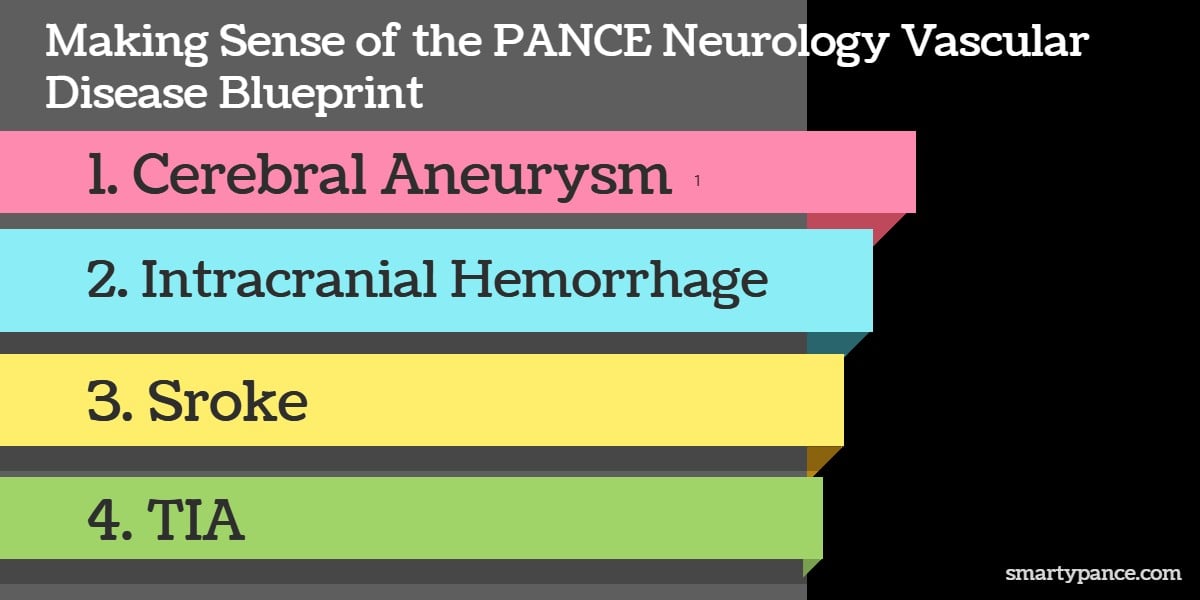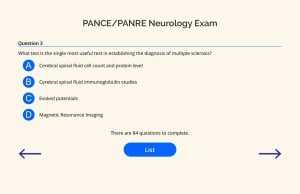Making Sense of the PANCE and PANRE Neurologic System Vascular Disease Content Blueprint
Today I will be dissecting the vascular disease section of PANCE/PANRE NCCPA Neurologic System Content Blueprint.
Because this part of the neurology blueprint has a lot of overlap and can cause a lot of confusion I will break it down here for you. I hope it helps.
I. A cerebral aneurysm can rupture and cause an intracranial hemorrhage.
- The most common type of intracranial hemorrhage caused by a ruptured cerebral aneurysm is a subarachnoid hemorrhage (see below) but they can also cause an intracerebral hemorrhage (also see blow).
II. Intracranial hemorrhages are divided into two classes which are then further subdivided:
- Extra-axial hemorrhage (bleeding that occurs outside of the brain tissue) which includes
- Epidural hematomas (caused by trauma)
- Subdural hematomas (caused by trauma)
- Subarachnoid hemorrhages (caused by cerebral aneurysm)
- Intra-axial hemorrhage (bleeding that occurs inside the brain tissue) which includes
- Intracerebral hemorrhage (hemorrhagic stroke - see next)
III. Strokes can be either ischemic or hemorrhagic
- Hemorrhagic strokes are just another name for an intracerebral hemorrhage. They are often secondary to hypertension and account for about 15% of strokes
- Two types of weakened blood vessels usually cause hemorrhagic stroke: aneurysms (see above) and arteriovenous malformations (AVMs)
- Ischemic strokes account for about 85% of all strokes. 2/3 of ischemic strokes are thrombotic and 1/3 are embolic
- Thrombotic strokes are caused by a blood clot that develops in the blood vessels inside the brain.
- Embolic strokes are caused by a blood clot or plaque debris that develops elsewhere in the body and then travels to one of the blood vessels in the brain through the bloodstream.
The symptoms must all present on one side and only one side - symptoms will be contralateral (the side of the body opposite the stroke)
- Right-sided symptoms = left side stroke.
- Left-sided symptoms = right side stroke.
| Carotid/Ophthalmic | Amaurosis fugax (monocular blind) |
| Middle Cerebral Artery (MCA) | Aphasia, neglect, hemiparesis, gaze preference, homonymous hemianopsia (visual field loss on the same side of both eyes) |
| Anterior cerebral artery (ACA) | Leg paresis, hemiplegia, urinary incontinence |
| Posterior cerebral artery (PCA) | homonymous hemianopsia (visual field loss on the same side of both eyes) |
| Vertebrobasilar artery | Coma, cranial nerve palsies, apnea, drop attach, vertigo |
| Lacunar stroke | Silent, pure motor or sensory stroke, "Dysarthria-Clumsy hand syndrome", ataxic hemiparesis |
IV. A transient ischemic attack is simply a neurologic deficit without acute infarction that lasts for less than 24 hours.
See, not so hard after all!







